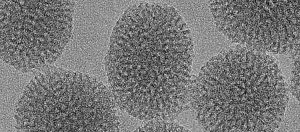Researchers from the University of Geneva (UNIGE) and the Ludwig Maximilians Universität München (LMU) say they have succeeded in using an in vitro screening technique to develop a fully biodegradable nanoparticle capable of delivering a new anti-inflammatory drug directly into macrophages, where uncontrolled inflammatory reactions are triggered.
The study “Inhibition of IL-1beta release from macrophages targeted with necrosulfonamide-loaded porous nanoparticles,” which appears in the Journal of Controlled Release, opens the door to a powerful and targeted anti-inflammatory treatment, according to the scientists.
“Two important mediators of inflammation are the cytokines IL-1beta and IL-18, which are produced by myeloid cells of the immune system, including macrophages. These cytokines are released into the extracellular space through pores formed in the plasma membrane by the oligomerized protein gasdermin D (GSDMD)” write the investigators.
“Necrosulfonamide (NSA) was recently identified as an effective GSDMD inhibitor and represents a promising therapeutic agent in GSDMD-dependent inflammatory diseases. Here, we targeted NSA to both mouse and human macrophages by using three different types of porous nanoparticles (NP), i.e. mesoporous silica (MSN), porous crosslinked cyclodextrin carriers (CD-NP), and a mesoporous magnesium-phosphate carrier (MPC-NP), all displaying high loading capacities for this hydrophobic drug.
“Cellular uptake and intracellular NSA delivery were tracked in time-lapse experiments by live-cell, high-throughput fluorescence microscopy, demonstrating rapid nanoparticle uptake and effective targeted delivery of NSA to phagocytic cells. Notably, a strong cytostatic effect was observed when a macrophage cell line was exposed to free NSA.
“In contrast, cell growth was much less affected when NSA was delivered via the nanoparticle carriers. Utilizing NSA-loaded nanoparticles, a successful concentration-dependent suppression of IL-1beta secretion from freshly differentiated primary murine and human macrophages was observed. Functional assays showed the strongest suppressive effect on human macrophages when using CD-NP for NSA delivery, followed by MSN-NP. In contrast, MPC-NP completely blocked the metabolic activity in macrophages when loaded with NSA.
“This study demonstrates the potential of porous nanoparticles for the effective delivery of hydrophobic drugs to macrophages in order to suppress inflammatory responses.”

“This is why this molecule is not yet available as a drug,” explained Gaby Palmer, PhD, a professor in the department of medicine and the Geneva Centre for Inflammation Research at the UNIGE Faculty of Medicine, who codirected the study. “Using a nanoparticle as a transport vessel would circumvent these shortcomings by delivering the drug directly into macrophages to combat inflammatory overactivation in the place where it begins.”
Three nanoparticles under the microscope
The scientists tested different porous nanoparticles, with the main criteria being a reduction in toxicity and in the required dosage, as well as the ability to release the drug only once the nanoparticle has reached the interior of the macrophages.
“We used an in vitro screening technology which we developed a few years ago on human and mouse cells. This saves time and greatly reduces the need to use animal models,’’ noted Carole Bourquin, PhD, a professor at the UNIGE’s Faculties of Science, who codirected this work at UNIGE. “Thus, only the most promising particles will then be tested on mice, which is a prerequisite for clinical trials on humans.”
Three different nanoparticles featuring high porosity were examined: a cyclodextrin-based nanoparticle, a substance commonly used in cosmetics or industrial food, a porous magnesium phosphate nanoparticle, and finally a porous silica nanoparticle.
“The first was less satisfactory in cell uptake behavior, while the second proved to be counterproductive: it triggered the release of pro-inflammatory mediators, stimulating the inflammatory reaction instead of fighting it,’” says Bart Boersma, a doctoral student in Carole Bourquin’s laboratory and first author of this study.
‘‘The porous silica nanoparticle, on the other hand, met all the criteria: it was fully biodegradable, of the right size to be swallowed by macrophages, and was able to absorb the drug into its numerous pores without releasing it too early. The anti-inflammatory effect was remarkable.”
The team then replicated their tests by coating the nanoparticles with an additional layer of lipid, but with no greater benefit than silica nanoparticles alone.
Other silica nanosponges developed by the German-Swiss team reportedly had already proven their effectiveness in transporting anti-tumor drugs.
“Here, they carry a very different drug that inhibits the immune system,’’ said Bourquin. ‘‘Mesoporous silica is increasingly revealing itself as a nanoparticle of choice in the pharmaceutical field, as it is effective, stable, and non-toxic. Nevertheless, each drug requires a tailor-made carrier: the shape, size, composition, and destination of the particles must be reassessed each time.”
Related Content on Drug Delivery Nanoparticles:
Lipid Nanoparticles Deliver for mRNA Vaccines
Nanoparticles Upgraded to Deliver Killer Sting on Recalcitrant Tumors
Study Unveils How Different Cancer Cells Respond to Drug Delivery Nanoparticles
Related Content on Anti-inflammatory drugs:
COVID-19 Treatment Hope Found in Anti-Inflammatory Drug
Anti-Inflammatory Drugs Demonstrate Pathway Savvy
Engineered Cartilage Releases Anti-Inflammatory Drug to Protect against Joint Stress






